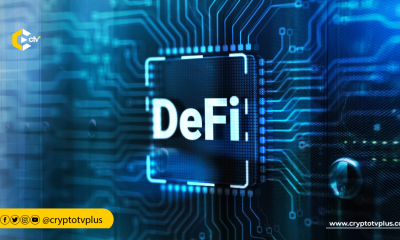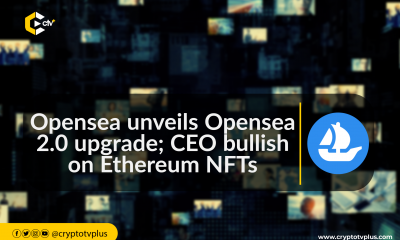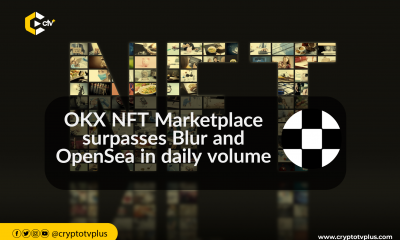FEATURED
WEF reveals 8 factors to drive NFT mass adoption

NFTs, or Non-Fungible Tokens, have rapidly become a focal point of innovation in the digital asset landscape.
From sports NFTs, gaming NFTs, and fashion NFTs to event ticket NFTs, real estate NFTs, music NFTs, and more, the traditional industry is embracing these blockchain utilities.
No wonder Statista projects that despite having a total market value of $1.6 billion in 2023, the NFT space will grow at an annual rate of 18.55% to reach $3.2 billion by 2027. If this happens, then there must be some factors that will drive it.
For the World Economic Forum, the major eight factors that will drive this growth and adoption are:
Regulatory and legal clarity
The regulatory landscape for NFTs remains nascent, with different countries crafting frameworks at varying paces. “Ultimately, a balanced regulation development will be critical to allow mass adoption,” it said.
In addition, it noted that “enforcing legal and regulatory frameworks will require strong international collaboration” and provide confidence for both users and companies.
Development of the Web3 ecosystem
WEF said that the current realities reveal that NFTs are intertwined with the broader Web3 ecosystem. Development of Web3 elements and functionalities is essential for user education, unlocking NFT potential, and expanding their use cases.
Although, it noted that there has been a slow pace in the industry recently because of collapses such as FTX and that the industry is still at the early stage, “NFT mass adoption will be supported by customer education and the adoption of general Web3 elements and functionalities.”
WEF also said that public and private investments in the broader Web3 ecosystem, including government support for digital identity adoption, will play a crucial role in driving widespread acceptance and use of Web3 technologies.
Macroeconomic and business environment
Another factor that will determine the growth of the NFT market is the macroeconomic environment. WEF said that this significantly impacts corporate investments in NFTs.
A stable economic climate is required to attract corporate resources, and market momentum without excessive hype is essential to avoid reputational damage to NFTs.
Additionally, it said that “market momentum and timing play a significant role in the decision process for companies adopting blockchain technology as they create visibility and increase media attention.”
Interoperability
WEF also believes that for a widespread NFT adoption to happen, interoperability standards must be established to allow NFTs to operate seamlessly across different blockchain networks and platforms. Incentives for collaboration will be crucial in overcoming interoperability challenges.
It added that the current situation is that several stakeholders are making efforts “to develop interoperability standards, though these attempts are still in their early stages and on a very small scale.”
To break the barriers of achieving interoperability, “the main challenge will likely not be technological or infrastructural but the requirement of building consensus and alignment across players from different industries with diverse interests to cooperate.”
User experience
NFT user experience needs improvement, particularly in wallet accessibility and security.
Simplifying wallets, integrating with Web2 platforms, and enhancing communication with non-crypto-savvy users will be pivotal for mass adoption.
WEF noted that because of the complexity of the NFT user experience, there is high friction in the customer journey, preventing everyday users from embarrassing NFTs.
The flourishing future will demand “effectively communicating and informing users through traditional Web2 channels and improving security and privacy measures in wallets and transactions.”
Technology development
The current hurdle facing the adoption of NFTs is that main chains find it difficult to balance cost-effectiveness, transaction capacity, security, and decentralization all at once.
This is because the underlying blockchain technology needs to improve in terms of throughput, latency, and security.
Addressing this issue and fostering adoption necessitates the availability of blockchain networks that offer high capacity, affordability, and security.
These attributes are fundamental for achieving widespread NFT adoption. “Data preservation, infrastructure developments, and open standards are key considerations,” WEF added.
Track Record of Success
Large-scale success stories and performance metrics are necessary to instill confidence in NFT investments. WEF said that the size of successes that have been recorded in the use of NFTs is not enough to attract more users let alone drive adoption.
Clear achievements and measurable success metrics will encourage companies to explore NFTs. “The emergence of large-scale success stories will undoubtedly boost companies’ confidence, encouraging them to move beyond small proof-of-concept experiments with NFTs,” the report reads.
Also, “these success stories need to be backed up by performance metrics that indicate the potential returns, reducing the perceived risk of investing in NFTs.”
The KPIs that will need to be seen will include “engagement rates, reduction of customer acquisition costs, increase in customer lifetime value, community growth, upselling/cross-selling or market adoption.”
IP and Brand Holders Adopting NFTs
The last factor mentioned by the organization is the involvement of companies with strong IP and recognized brands. This is important as they must develop NFTs that offer real value to the community.
Furthermore, the report emphasizes the need for new IP regulations to clarify the permissible actions of each participant within the value chain in relation to NFT rights usage.
Conclusively, the WEF explained that the convergence of these factors will be critical in driving NFTs toward mass adoption. It believes that NFTs can make huge impacts in the various industries mentioned in the report.
However, it said that they are still in the early stages and require further development for widespread adoption.
Read also; WEF Report: How NFTs have affected the gaming industry
























